
- Britains Toy Soldiers
- Brand
- Britain (15)
- Britain's (24)
- Britains (2972)
- Britains Deetail (374)
- Britains Ltd (19)
- Charbens (31)
- Crescent (21)
- Deetail (37)
- Herald (19)
- Johillco (26)
- King & Country (34)
- Swoppet (78)
- Taylor & Barrett (17)
- Trophy Miniatures (14)
- W Britain (40)
- W Britains (46)
- W. Britain (37)
- W.britain (45)
- William Britain (152)
- William Britains (95)
- ... (1952)
- Era
- Material
- Cast Iron (6)
- Die Cast (6)
- Diecast (17)
- Diecast Metal (17)
- Lead (645)
- Lead - Metal (11)
- Metal (199)
- Metal (lead) (5)
- Painted Lead (1237)
- Painted Metal (155)
- Painted Plastic (323)
- Painted Tin (15)
- Painted White Metal (8)
- Paper (11)
- Pewter (26)
- Plastic (91)
- Plastic & Metal (7)
- Polystone Resin (8)
- Resin (8)
- White Metal (16)
- ... (3237)
- Nationality
- Scale
- Type
- Accessories (102)
- Artillery (68)
- Castle (8)
- Castles / Buildings (39)
- Diorama Accessories (9)
- Elephant (9)
- Farm (14)
- Figure (221)
- Horse (13)
- Horses (66)
- Knight (20)
- Lambeth Walk Dancers (9)
- Military (21)
- Military Personnel (1321)
- Scenary (18)
- Soldat (14)
- Soldier (207)
- Tank (19)
- Toy Soldiers (13)
- Vehicles (50)
- ... (3807)
Zulu War Britains Huge Box Set 5198 Rorkes Drift 1879 Hospital Defence Diorama
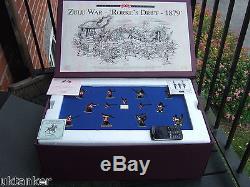
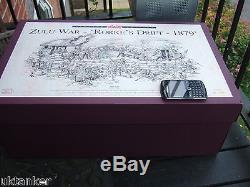
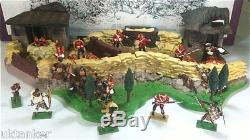
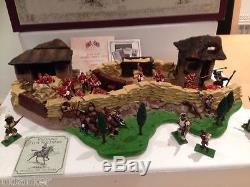
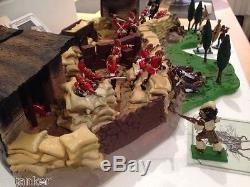
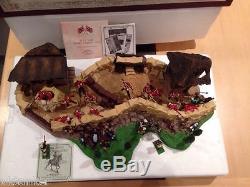
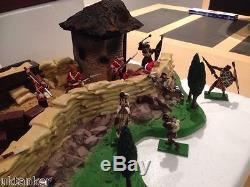
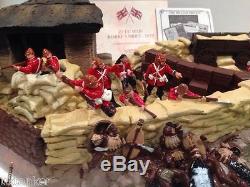
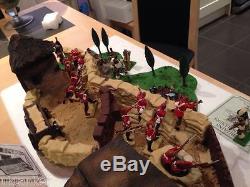
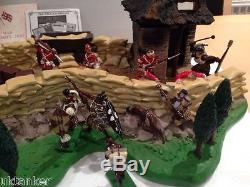
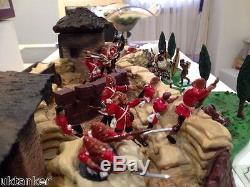
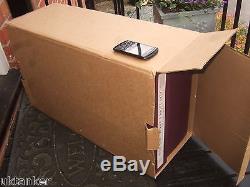


Rare New Zulu Wars Britains Huge Box Set 5198 Rorkes Drift 1879 Hospital Defence Diorama. Britains Lead Soldiers Range Celebrating Pageantry-Heritage and Tradition. Looking to treat yourself, or get something special for any Britains figures collector or Soldier Figure enthusiast you may know? This large boxed set is the ultimate Britains Collector Set, with rarity, quality, detail and value.
Name of toy and collectable soldiers is derived from a company founded by William Britain Jr. Invented the process of hollow casting. In lead, and revolutionized the production of toy soldiers. The company quickly became the industry leader, and was imitated by many other companies, such as Hanks Bros. And John Hill and Co.
The style and scale of Britain's figures became the industry standard for toy and model soldiers for many years. This is a listing for what is possibly the largest box set from Britains that i have ever seen. Its the superbly detailed Britains Rare New Huge Box Set number 5198, of Zulu Wars, Rorkes Drift in 1879, The Hospital Defence Diorama, complete with everything you need in the box, including walls, buildings, base, accessory detail built in, plus soldiers and zulu's and much more.
This Large Set further features several characters from the actual event, and the eventual film, including Lt Bromhead, Colour Sergeant Bourne, Some Privates from B Company 24Th Foot, plus King Cetshwayo Ka Mpande, Udibi Boy, plus other Zulu characters. Many of the figures are formed into the actual casting, many more are seperate figures, and together they may a fantastic looking realistic and true to actual events dioramic scene of the historic Hospital Defence at Rorkes Drift, which is one of the most heroic and memorable events in Boer-Zulu history. Scale is 1:32 and all figures are hand painted and well detailed. It is possible to add your own detail , accessories and figures too of course, to make the ultimate diorama your very own.
The set is New and comes in perfect condition, and still with the manufacturers Brown Trade outer Box in which it will be posted. In USA this very set went for 700 Dollars. My new one complete with outer mailer will be will be much less. The figures are all meticuously detailed , and hand painted, and detail and quality is typical of Britains. The Inner box is in Excellent New condition , the large outer box has fairly minor shop wear to it and is in Very Good condition. I have several of these Soldier sets on sale, and other ones to be listed soon, also single unit Scottish pipers and other Scottish Bandsmen figures and bandsmen either already up or going up soon, including Bugler, Big Drum, Pipe major etc. Please note , some items value is such that i prefer to send it to some Countrys. At the moment, where a much higher than acceptable amount of packages appear to go amiss?? But i reserve the right to include others depending on cost of item and which Country.The Price quoted for Europe is non tracked. So buyers from Italy please let me invoice you. I have more items like this, or similar, plus lots of other great products either already up, or coming soon.
Battle of Rorke's Drift. From Wikipedia, the free encyclopedia. Part of the Anglo-Zulu War. The Defence of Rorke's Drift , by Alphonse de Neuville. Rorke's Drift, Natal Province, South Africa. Regulars 11 colonial troops 4 civilians. INdluyengwe ibutho: 500 to 700 men. UThulwana, iNdlondo, uDluko amabuthos: c. The Battle of Rorke's Drift , also known as the Defence of Rorke's Drift , was a battle in the Anglo-Zulu War.The defence of the mission station. Of Rorke's Drift, under the command of Lieutenant John Chard. Immediately followed the British Army. S defeat at the Battle of Isandlwana.
On 22 January 1879, and continued into the following day, 23 January. Just over 150 British and colonial troops successfully defended the garrison against an intense assault by 3,000 to 4,000 Zulu warriors. Attacks on Rorke's Drift came very close to defeating the tiny garrison but were ultimately repelled. Were awarded to the defenders, along with a number of other decorations and honours. The cattle kraal and the bastion. Victoria Crosses and Distinguished Conduct Medals. Rorke's Drift, known as kwaJimu.("Jim's Land") in the Zulu language. And the former trading post. Of James Rorke, an Irish merchant. It was located near a drift, or ford.
(Mzinyathi) River, which at the time formed the border between the British colony of Natal. On 9 January 1879, the British No. 3 (Centre) Column, under Lord Chelmsford.Arrived and encamped at the drift. On 11 January, the day after the British ultimatum. To the Zulus expired, the column crossed the river and encamped on the Zulu bank.
A small force consisting of B Company, 2nd Battalion, 24th (2nd Warwickshire) Regiment of Foot. (2nd/24th) under Lieutenant Gonville Bromhead.Was detailed to garrison the post, which had been turned into a supply depot and hospital under the overall command of Brevet Major Henry Spalding, 104th Foot. A member of Chelmsford's staff. On 20 January, after reconnaissance patrolling and building of a track for its wagons, Chelmsford's column marched to Isandlwana, approximately 6 miles (9.7 km) to the east, leaving behind the small garrison. A large company of the 2nd/3rd Natal Native Contingent.
(NNC) under Captain William Stevenson was ordered to remain at the post to strengthen the garrison. This company numbered between 100 and 350 men.Captain Thomas Rainforth's G Company of the 1st/24th Foot was ordered to move up from its station at Helpmekaar, 10 miles (16 km) to the southeast, after its own relief arrived, to further fortify the drift. Later that evening a portion of the No. 2 Column under Brevet Colonel Anthony Durnford. Late of the Royal Engineers.
Arrived at the drift and camped on the Zulu bank, where it remained through the next day. Late on the evening of 21 January, Durnford was ordered to Isandlwana, as was a small detachment of No. 5 Field Company, Royal Engineers.
Commanded by Lieutenant John Chard. Which had arrived on the 19th to repair the pontoons. Chard rode ahead of his detachment to Isandlwana on the morning of 22 January to clarify his orders, but was sent back to Rorke's Drift with only his wagon and its driver to construct defensive positions for the expected reinforcement company, passing Durnford's column en route in the opposite direction. Sometime around noon on the 22nd, Major Spalding left the station for Helpmekaar to ascertain the whereabouts of Rainforth's G Company, which was now overdue. He left Chard in temporary command.Chard rode down to the drift itself where the engineers' camp was located. Soon thereafter, two survivors from Isandlwana Lieutenant Gert Adendorff. Of the 1st/3rd NNC and a trooper from the Natal Carbineers. Arrived bearing the news of the defeat and that a part of the Zulu impi. Upon hearing this news, Chard, Bromhead, and another of the station's officers, Acting Assistant Commissary James Dalton.
Of the Commissariat and Transport Department. , held a quick meeting to decide the best course of action whether to attempt a retreat to Helpmekaar or to defend their current position.
Dalton pointed out that a small column, travelling in open country and burdened with carts full of hospital patients, would be easily overtaken and defeated by a numerically superior Zulu force, and so it was soon agreed that the only acceptable course was to remain and fight. Once the British officers decided to stay, Chard and Bromhead directed their men to make preparations to defend the station. With the garrison's some 400 men. Working quickly, a defensive perimeter was constructed out of mealie. This perimeter incorporated the storehouse, the hospital, and a stout stone kraal. The buildings were fortified, with loopholes.(firing holes) knocked through the external walls and the external doors barricaded with furniture. (NNH) under Lieutenant Alfred Henderson arrived at the station after having retreated in good order from Isandlwana. They volunteered to picket the far side of the Oscarberg. (Shiyane), the large hill that overlooked the station and from behind which the Zulus were expected to approach.
With the defences nearing completion and battle approaching, Chard had several hundred men available to him: Bromhead's B Company, Stevenson's large NNC company, Henderson's NNH troop, and various others (most of them hospital patients, but'walking wounded') drawn from various British and colonial units. Adendorff also stayed, while the trooper who had ridden in with him galloped on to warn the garrison at Helpmekaar. The force was sufficient, in Chard's estimation, to fend off the Zulus. Chard posted the British soldiers around the perimeter, adding some of the more able patients, the'casuals' and civilians, and those of the NNC who possessed firearms along the barricade.
The rest of the NNC, armed only with spears, were posted outside the mealie bag and biscuit box barricade within the stone-walled cattle kraal. The approaching Zulu force was vastly larger; the uDloko. Amabutho (regiments) of married men in their 30s and 40s and the inDlu-yengwe. Ibutho of young unmarried men mustered 3,000 to 4,000 warriors, none of them engaged during the battle at Isandlwana.
This Zulu force was the'loins' or reserve of the army at Isandlwana and is often referred to as the Undi Corps. It was directed to swing wide of the British left flank and pass west and south of Isandlwana hill itself, in order to position itself across the line of communication. And retreat of the British and their colonial allies in order to prevent their escape back into Natal by way of the Buffalo River ford leading to Rorke's Drift. Most Zulu warriors were armed with an assegai.
(short spear) and a shield made of cowhide. The Zulu army drilled in the personal and tactical use and coordination of this weapons system. Some Zulus also had old muskets and antiquated rifles, though their marksmanship training was poor, and the quality and supply of powder and shot was dreadful. Historical picture of Zulu warriors from about the same time as the events at Rorke's Drift. The Zulu attitude towards firearms was that: The generality of Zulu warriors, however, would not have firearms the arms of a coward, as they said, for they enable the poltroon. To kill the brave without awaiting his attack. Even though their fire was not accurate, it was responsible for five of the seventeen British deaths at Rorke's Drift.While the Undi Corps had been led by inkhosi kaMapitha at the Isandlwana battle, the command of the Undi Corps passed to Prince Dabulamanzi kaMpande. The Zulu king when kaMapitha was wounded during the pursuit of British fugitives from Isandlwana. Prince Dabulamanzi was considered rash and aggressive, and this characterisation was borne out by his violation of King Cetshwayo's order to act only in defence of Zululand against the invading British soldiers and not carry the war over the border into enemy territory.
The Rorke's Drift attack was an unplanned raid rather than any organised counter-invasion, with many of the Undi Corps Zulus breaking off to raid other African kraals and homesteads while the main body advanced on Rorke's Drift. Otto Witt the Swedish missionary. Who ran the mission at Rorke's Drift and army chaplain Reverend George Smith. Came down from the Oscarberg hillside with the news that a body of Zulus was fording the river to the southeast and was "no more than five minutes away". At this point, Witt decided to depart the station, as his family lived in an isolated farmhouse about 30 kilometres (19 mi) away, and he wanted to be with them.
Witt's native servant, Umkwelnantaba, left with him; so too did one of the hospital patients, Lieutenant Thomas Purvis of the 1st/3rd NNC. This section needs additional citations for verification. Please help improve this article.By adding citations to reliable sources. Unsourced material may be challenged and removed. Contemporary drawing of Rorke's Drift Post, from the history of the Corps of Royal Engineers.
The Defence of Rorke's Drift by Lady Butler. Among those depicted are Lieutenants Chard and Bromhead (centre) commanding the battle, Private Hitch (right, standing) handing out ammunition while wounded, and Surgeon Reynolds and Storekeeper Byrne tending to the wounded Corporal Scammell (Reynolds kneeling; Byrne falling, shot). Possibly Corporal Schiess is shown at centre background at the barricade just to left of Chard and Bromhead in NNC uniform face not shown. However, tired from the battle and retreat from Isandlwana and short of carbine ammunition, Henderson's men departed for Helpmekaar. Henderson himself reported to Lieutenant Chard that the enemy were close and that "his men would not obey his orders but were going off to Helpmekaar". Henderson then followed his departing men. Upon witnessing the withdrawal of Henderson's NNH troop, Captain Stevenson's NNC company abandoned the cattle kraal and fled, greatly reducing the strength of the defending garrison. Outraged that Stevenson and some of his colonial NCOs.Also fled from the barricades, a few British soldiers fired after them, killing Corporal William Anderson. With the Zulus nearly at the station, the garrison now numbered between 154 and 156 men. Of these, only Bromhead's company could be considered a cohesive unit. Additionally, up to 39 of his company were at the station as hospital patients, although only a handful of these were unable to take up arms.
With fewer men, Chard realised the need to modify the defences, and he gave orders for the construction of a biscuit-box wall through the middle of the post in order to make possible the abandonment of the hospital side of the station if the need arose. Posted as lookout atop the storehouse, reported a large column of Zulus approaching. The Zulu vanguard, 600 men of the iNdluyengwe, attacked the south wall, which joined the hospital and the storehouse. The British opened fire at 500 yards (460 m). The majority of the attacking Zulu force swept around to attack the north wall, while a few took cover and were either pinned by continuing British fire or retreated to the terraces of Oscarberg.
There they began a harassing fire of their own. As this occurred, another Zulu force swept onto the hospital and north west wall.Those British on the barricades including Dalton and Bromhead were soon engaged in fierce hand-to-hand fighting. The British wall was too high for the Zulus to scale, so they resorted to crouching under the wall, trying to get hold of the defenders' Martini-Henry.
Rifles, slashing at British soldiers with assegais. Or firing their weapons through the wall. At places, they clambered over each other's bodies to drive the British off the walls but were driven back. Zulu fire, both from those under the wall and around the Oscarberg, inflicted a few casualties, and five of the 17 defenders who were killed or mortally wounded in the action were struck while at the north wall. The hospital was becoming untenable; the loopholes had become a liability, as rifles poking out were grabbed at by the Zulus but, if the holes were left empty, the Zulu warriors stuck their own weapons through to fire into the rooms.
Among the soldiers assigned to the hospital were Corporal William Wilson Allen. And Privates Cole, Dunbar, Hitch, Horrigan, John Williams.
Joseph Williams, Alfred Henry Hook. Privates Horrigan, John Williams, Joseph Williams and patients tried to hold the hospital entrance with rifles and fixed bayonets. Joseph Williams defended a small window, and 14 dead Zulus were found later beneath the window. As it became clear that the front of the building was being taken by the Zulus, John Williams began to hack a way of escape through the wall dividing the central room and a corner room in the back of the hospital. As he made a passable hole, the door into the central room came under furious attack from the Zulus, and he only had time to drag two bedridden patients out before the door gave way. The corner room that John Williams had pulled the two patients into was occupied by Private Hook and another nine patients. John Williams hacked at the wall to the next room with his pick-axe, as Hook held off the Zulus.Williams made the hole big enough to get into the next room, which was occupied only by patient Private Waters, and dragged the patients through. The last man out was Hook, who killed some Zulus who had knocked down the door before he dived through the hole. John Williams once again went to work, spurred by the fact that the roof was now on fire, as Hook defended the hole and Waters continued to fire through a loophole.
After fifty minutes, the hole was large enough to drag the patients through, and the men save Privates Waters and Beckett, who hid in the wardrobe (Waters was wounded and Beckett died of assegai wounds) were now in the last room, being defended by Privates Robert Jones and William Jones. From here, the patients clambered out through a window and then ran across the yard to the barricade. Of the eleven patients, nine survived the trip, as did all the able-bodied men.According to James Henry Reynolds. Only four defenders were killed in the hospital: one was a member of the Natal Native Contingent with a broken leg; Sgt Maxfield and Private Jenkins, who were ill with fever and refused to be moved. Reportedly, Jenkins was killed after being seized and stabbed, together with Private Adams who also refused to move.
Private Cole, assigned to the hospital, was killed when he ran outside. Another hospital patient killed was Trooper Hunter of the Natal Mounted Police. Among the hospital patients who escaped were a Corporal Mayer of the NNC; Bombardier Lewis of the Royal Artillery, and Trooper Green of the Natal Mounted Police, who was wounded in the thigh by a spent bullet. Private Conley with a broken leg was pulled to safety by Hook, although Conley's leg was broken again in the process. The evacuation of the burning hospital completed the shortening of the perimeter. As night fell, the Zulu attacks grew stronger. By that time, the garrison had lost 14 dead.Two others were mortally wounded and 8 more including Dalton were seriously wounded. Virtually every man had some kind of wound. They were all exhausted, having fought for the better part of ten hours and were running low on ammunition. Of 20,000 rounds in reserve at the mission, only 900 remained. Modern view of battle site.
The buildings are modern, and their positions do not reflect the positions of the storehouse and hospital which were there during the battle. As dawn broke, the British could see that the Zulus were gone; all that remained were the dead and severely wounded. Patrols were dispatched to scout the battlefield, recover rifles, and look for survivors, many of whom were executed when found. Of Zulus suddenly appeared, and the British manned their positions again.
No attack materialised however, as the Zulus had been on the move for six days prior to the battle and had not eaten properly for two. In their ranks were hundreds of wounded, and they were several days' march from any supplies. Soon after their appearance, the Zulus left the way they had come.
Left their breakfast to man their positions again. However, the force turned out to be the vanguard of Lord Chelmsford.Breakdown of British and colonial casualties. 1st/24th Foot: 4 killed or mortally wounded in action; 2 wounded. 2nd/24th Foot: 9 killed or mortally wounded in action; 9 wounded. 1 killed in action; 1 wounded. 1st/3rd NNC: 1 killed in action.
Also, as mentioned, one member of Stevenson's 2nd/3rd NNC, Corporal William Anderson, was killed by British fire while fleeing the station just prior to the arrival of the Zulus. 351 Zulu bodies were counted after the battle, but it has been estimated that at least 500 wounded and captured Zulus might have been massacred. Having witnessed the carnage at Isandlwana, the members of Chelmsford's relief force had no mercy for the captured, wounded Zulus they came across. Nor did the station's defenders.Trooper William James Clarke of the Natal Mounted Police described in his diary that altogether we buried 375 Zulus and some wounded were thrown into the grave. Seeing the manner in which our wounded had been mutilated after being dragged from the hospital... We were very bitter and did not spare wounded Zulus.
Laband, in his book The Zulu Response to the British Invasion of 1879 , accepts the estimate of 600 that Shepstone had from the Zulus. In 1914 that the official enemy death toll was too low: "We reckon we had accounted for 875, but the books will tell you 400 or 500". A member of Chelmsford's staff, wrote that the day after the battle an improvised gallows was used "for hanging Zulus who were supposed to have behaved treacherously". Main article: List of Zulu War Victoria Cross recipients.Were awarded to the defenders of Rorke's Drift, seven of them to soldiers of the 2nd/24th Foot the most ever received in a single action by one regiment although not, as commonly thought, the most awarded in a single action or the most in a day: 16 were awarded at the Battle of Inkerman. On 5 November 1854; 28 were awarded during the Second Relief of Lucknow. This high number of awards for bravery has been interpreted as a reaction to the earlier defeat at the Battle of Isandlwana. The extolling of the victory at Rorke's Drift drawing the public's attention away from the great defeat at Isandlwana and the fact that Lord Chelmsford and Bartle Frere had instigated the war without the approval of Her Majesty's Government. Taking over as commander-in-chief from Lord Chelmsford later that year, was unimpressed with the awards made to the defenders of Rorke's Drift, saying "it is monstrous making heroes of those who, shut up in buildings at Rorke's Drift, could not bolt and fought like rats for their lives, which they could not otherwise save".
Several historians have challenged this assertion and pointed out that the victory stands on its own merits, regardless of other concerns. Responded to it directly in "Why the West has Won" saying, Modern critics suggest such lavishness in commendation was designed to assuage the disaster at Isandhlwana and to reassure a skeptical Victorian public that the fighting ability of the British soldier remained unquestioned. Maybe, maybe not, but in the long annals of military history, it is difficult to find anything quite like Rorke's Drift, where a beleaguered force, outnumbered forty to one, survived and killed twenty men for every defender lost. Lieutenant John Rouse Merriott Chard. 5th Field Coy, Royal Engineers. Acting Assistant Commissary James Langley Dalton. In 1879 there was no provision for the posthumous granting of the Victoria Cross, and so it could not be awarded to anyone who had died in performing an act of bravery. In light of this, an unofficial'twelfth VC' may be added to those listed: Private Joseph Williams, B Coy, 2nd/24th Foot, who was killed during the fight in the hospital and for whom it was mentioned in despatches. That "had he lived he would have been recommended for the Victoria Cross". Awarded the Distinguished Conduct Medal. Gunner John Cantwell; N Batt, 5th Brig Royal Horse Artillery. (demoted from bombardier wheeler the day before the battle). Private John William Roy; 1st/24th Foot. Colour Sergeant Frank Edward Bourne.Second Corporal Francis Attwood; Army Service Corps. On 15 January 1880, a submission for a DCM was also made for Private Michael McMahon Army Hospital Corps. The submission was cancelled on 29 January 1880 for absence without leave and theft. The events surrounding the assault on Rorke's Drift were first dramatised by military painters, notably Elizabeth Butler.
Their work was vastly popular in their day among the citizens of the British empire. In 1914, a touring English Northern Union. Rugby league team defeated Australia. 14-6 to win the Ashes.
In the final Test match. Depleted by injuries and fielding only ten men for much of the second half, the English outclassed and outfought the Australians in what quickly became known as the' Rorke's Drift Test. Is a depiction of the Battle of Rorke's Drift. The film received generally positive reviews from the critics. Some details of the film's account have, however, been criticised.
As historically inaccurate for example, in the movie the regiment is called the South Wales Borderers. But the unit was not in fact called that until two years after the battle, although the regiment had been based at Brecon in South Wales since 1873. While most of the men of the 1st Battalion, 24th Regiment of Foot (1/24) were recruited from the industrial towns and agricultural classes of England, principally from Birmingham. And adjacent southwest counties, only 10 soldiers of the 1/24 that fought in the battle were Welsh. Many of the soldiers of the junior battalion, the 2/24, were Welshmen.Of the 122 soldiers of the 24th Regiment present at the Battle of Rorke's Drift, 49 are known to have been of English nationality, 32 were Welsh, 16 were Irish, 1 was a Scot, and 3 were born overseas. The nationalities of the remaining 21 are unknown. In 1990 the game developer Impressions Games. Released a video game based on the historical battle. The battle was also featured by Mad Doc Software in its 2006 strategy game Empire Earth II.
The Art of Supremacy as one of its "turning point" battle modes. The battle of Rorke's Drift was given a chapter in military historian. S book Carnage and Culture (2002) as one of several landmark battles demonstrating the superior effectiveness of Western military practices. Rorke's Drift Art and Craft Centre. Military history of South Africa.
Zulu: Isandlwana and Rorke's Drift , 1992, pp. The Noble 24th , Savannah Publications, ISBN 1-902366-04-2. England's Sons , Gift Ltd. History of the Zulu War and Its Origin , London, 1880, p. 305, gives 3,000; Knight, Ian.The Zulu War 1879 , Osprey, 2003, ISBN 1-84176-612-7. 37, Knight gives: "in excess of 3,000"; Lock, Ron; Quantrill, Peter (2005). Zulu Victory: The Epic of Isandlwana and the Cover-up. The Washing of the Spears. Da Capo Press, 1998, gives over 4,000.
Knight, Ian, Rorke's Drift 1879, "Pinned Like Rats in a Hole" ; Osprey Campaign Series #41, Osprey Publishing. Porter, Whitworth (1889), South African Wars, 18471885 , History of the Corps of Royal Engineers, II , London: Longmans, Green, and Co. 33, 17 killed and 10 wounded. (including one killed by'friendly fire' while fleeing the garrison at start of the battle). Lock, Ron; Quantrill, Peter (2005). Excerpt from private journal of Lieutenant Colonel John North Crealock, Crealock states "351 dead were found and 500 wounded". Ian Knight, The Zulu War 1879 , Osprey, 2003, ISBN 1-84176-612-7. 23, The post was guarded by one company of 2/24... And a company of the NNC...Estimates vary: Thompson, Paul Singer. 27, gives 100 to 300. Redcoats and Zulus , 2004, p.
28, With 400 men to build them... Morris The Washing of the Spears , Da Capo Press, 1998, p. 370, "played no part in the battle". 462 They had a national army of twenty-five thousand men equipped with cowhide shields, assegais and clubs.Lock, Ron; Quantrill, Peter (2005). 62, John Shepstone, Acting Secretary for Native Affairs at the time, on the Zulu army Equipment: Each man carries his shield and assegais, and a kaross or blanket if he possesses one, he may also have a war dress of monkey skins or ox tails, this is all. Section'War of 1879', subsection'Weapons. 38, Although the Zulu position was a commanding one a squad of good shots armed with efficient rifles could have made Chard's position untenable within minutes the Zulus were neither good shots, nor well armed.
Porter, Whitworth (1889), "Drawing, Rorke's Drift Post", History of the Corps of Royal Engineers. II , London: Longmans, Green, and Co, p. Knight, Ian, Rorke's Drift 1879, "Pinned Like Rats in a Hole" ; Osprey Campaign Series #41, Osprey Publishing 1996, ISBN 1-85532-506-3. 88 this is described by Knight as "the first shots of the battle".
The Washing of the Spears , Da Capo Press, 1998, p. This reduced the strength of the defenders drastically... 45, Corporal Scammell of the NNC is noted as remaining. England's Son , Gift Ltd.2004, gives the most up-to-date analysis of the numbers present at the Battle of Rorke's Drift. He counts 154 definite participants, with 2 others listed as "possibles".
Porter, Whitworth, South African Wars, 18471885 , History of the Corps of Royal Engineers, II , London: Longmans, Green, and Co. Private Henry Hook's account in The Royal Magazine. Leaders and Battles: The Art of Military Leadership. Private Henry Hook's account in The Royal Magazine 1905.Julian Whybra (2004) England's Sons pp. It is possible that all the Zulu wounded were put to death. Rorke's Drift , The Guardian. 21 April 2009, gives "about 400 Zulus" killed.
Legendary Battle of Anglo-Zulu War marred by brutal aftermath , The Guardian. Spiers, The Scottish Soldier and Empire, 18541902 , Edinburgh University Press, 2006, p. Also: Ian Knight, Zulu War , Osprey, 2004, p.
9, By late 1878 Frere had manipulated a diplomatic crisis with the Zulus... Colenso, History of the Zulu War and Its Origin , London, 1880, pp. Are evidently such as he (Cetshwayo) may not improbably refuse, even at the risk of war... To preclude you from incurring the delay... Involved in consulting Her Majesty's Government upon a subject of so much importance as the terms...
Also: Ian Knight, Zulu War , Osprey, 2004, p. An ultimatum with which, Frere knew, they could not possibly comply. "Why the West has Won", pg 333, Hanson, V. England's Sons Gift Ltd.
Michael Snook, Like Wolves on the Fold (2006) pp. Julian Whybra (2004) England's Sons p.
"40,000 Cheered When Wagstaff's 1914 Team Beat Australians With Eleven Men". British History in Depth , BBC. "The Royal Regiment of Wales". Norman Holme (1999) The Noble 24th p.History of the Zulu War and Its Origin , London, 1880. Discussed Rorke's Drift and the politics of the Victoria Cross Roy Morris Jr. Military Heritage , August 2005, Volume 7, No. Greaves, Adrian, Rorke's Drift , Cassell, London, 2002.
Kingdom in Crisis: The Zulu Response to the British Invasion of 1879. (1889), "South African Wars, 18471885", History of the Corps of Royal Engineers. II , London: Longmans, Green, and Co, pp. Snook, Lt Col Mike, Like Wolves on the Fold: The Defence of Rorke's Drift. The style and scale of Britain's figures became the industry standard for toy soldiers for many years.
In 1907 the family proprietorship, William Britain & Sons, incorporated as Britains, Ltd. They combined the operations with an existing line of toys and renamed the company Britains Petite, Ltd. During the first half of the 20th century, Britains expanded its range and market. By 1931 the firm employed 450 at its London factory. The catalogue had expanded to 435 sets and twenty million models a year were being produced.
Britains Set 212 The Royal Scots. From the early 20th Century and up until 1930, Fred Whisstock. Was employed by Britain's to design the box labels.
In the 1950s Britains acquired Herald Miniatures. Plastic figures designed by Roy Selwyn-Smith. By 1966 safety regulations in the United Kingdom combined with rising costs halted the production of lead toy soldiers. Britains shifted most production of Herald plastic to Hong Kong from 1966. In 1976 Britains started Deetail. Plastic figures with metal bases that were initially manufactured in England but later were manufactured in China. When production stopped, the range of catalogued lead sets exceeded 2200. In 1973 Britains introduced New Metal models, which are die cast. Initially these sets were aimed at the British souvenir market.In 1983 Britains responded to a growing collectors market by introducing additional models and limited edition sets. This range was greatly expanded over the next 20 years and included die-cast versions of their old toy soldiers, some made from original moulds. These, as well as their lines of Deetail. Plastic figures and accessories, and their older sets have become highly collectable.
They are also known for their American Revolutionary War soldiers. In 1997 Britains Petite, Ltd was bought by Ertl Company. A maker of die-cast toys. Ertl was subsequently bought by Racing Champions, another American die cast model maker.
At this time production of toy soldiers was moved to China. Britains brand was acquired by First Gear, an American maker of die cast collectables. This firm produces and sells mostly contemporary matte-style figures to the collectors market under the W. Osen is the Master Sculptor for W. All figures are sculpted by hand, to scale before duplicating.
I will always leave Feedback once Feedback has been left for me, but please give it plenty of time as i do mine once weekly. My auctions are always nearly for 10 days to allow for this. Last minute questions might not get answered. I always get certificate of posting to prove proof of posting. I post items daily from the UK. I do everything there is relating to these items. Usually its approx 1 to 3 days for 1st class post, and 2-5 days for 2nd class post, but all post can take up to a week, or more at peak times like Christmas. The best way round this is, if you can, is to combine with other items. This is a normal small charge applied by most sellers, and in our case its lower than most, as we do realise that with the Royal Mails ever increasing their postal costs, that its a concern for all buyers. One thing to realise is that recent Postal changes within the UK, means that. All items up to 750 Gramms. Now cost exactly the same rate.We hope you've found what you need. Items will be posted as securely as possible, and marked clearly. Check out my other items. The item "Zulu War Britains Huge Box Set 5198 Rorkes Drift 1879 Hospital Defence Diorama" is in sale since Thursday, June 25, 2015.
This item is in the category "Toys & Games\Toy Soldiers\Britains". The seller is "uktanker" and is located in Thatcham, Berkshire. This item can be shipped to United Kingdom.
- Brand: Britains
- Material: Painted Lead
- Nationality: Britain
- MPN: 5198

